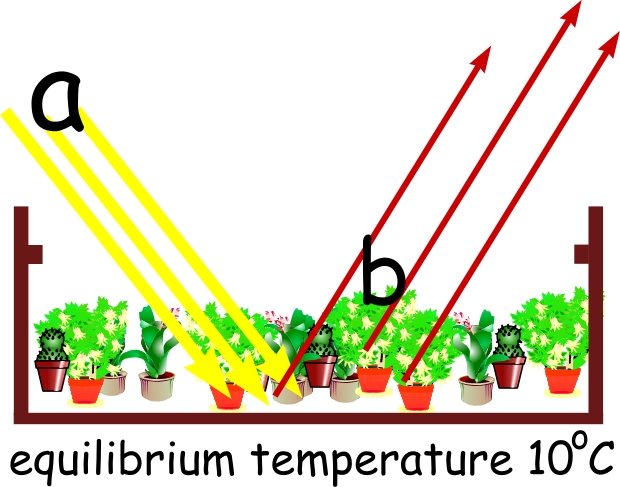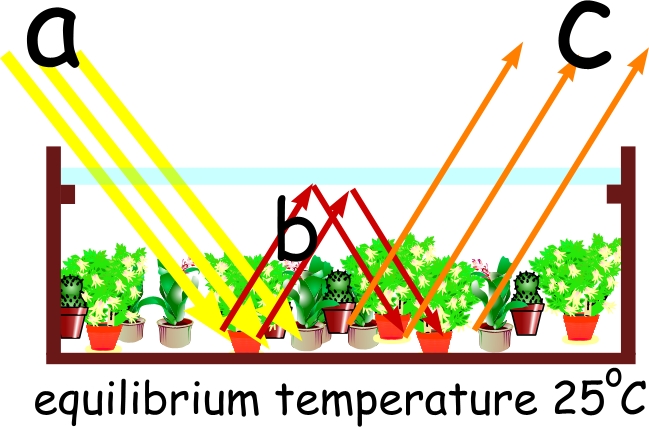Greenhouses on Mars
Designed for: Grades K-8 For use by:
Students, Teachers.
Learning Styles: Classroom based
Resource Type: Document
Dynamic equilibrium (Energy in = energy out)
The essential requirement for achieving a stable ecosystem relies upon the ecosystem’s ability to attain a condition known as dynamic equilibrium. In a condition of dynamic equilibrium all resources are recycled (or replaced) at a rate that, on average, exactly balances the rate at which these resources are consumed (or removed) from the ecosystem.
Ecosystem resources can be divided into two main groups:
- Physical resources such as water, carbon (usually in molecular compounds) and nitrogen (generally in the form of nitrates) and traces of numerous other essential elements.
- Energy (generally in the form of food, heat, or sunlight).
Solar energy and heat
Consider the Sun shining directly down on one square metre of the Martian surface (for example: at local noon on Mars’ equator on the day of the Martian equinox). The incoming solar energy is 590 watts per square metre. In scientific terms we would say the irradiation is 590W/m2.
The surface of Mars will heat up until a condition of dynamic equilibrium is reached; that is, until exactly 590 watts per square metre is radiated back into space. To radiate this amount of energy into space the surface will need to reach a temperature of about 115oC (46oC). This seems quite hot, given that Mars is actually so cold! The reason is that, as on Earth, the full heating effect of the Sun occurs only for a brief period near local noon each day and only ever gets directly overhead in locations between the tropics (between the Tropic of Cancer and the Tropic of Capricorn).
At night the surface of Mars radiates energy into space so efficiently that even on the equator, nighttime temperatures can drop below -140°F (-100oC). As the Sun slowly rises in the Martian dawn its heating ability is weak, by noon the surface temperature has risen only slightly. As the Sun passes “noon” its angle above the horizon decreases… there is insufficient time for the surface to reach its maximum possible equilibrium temperature.
Averaged over the whole surface of Mars, a condition of dynamic thermal equilibrium is reached at a global average temperature of a bone chilling -50°F (minus forty six degrees Fahrenheit)!
Is it possible to raise the dynamic equilibrium temperature on the surface of Mars?
Since it is not possible to increase the solar irradiance we must arrange conditions so that the radiation of energy back into space occurs at a higher temperature. In the parlance of scientific terminology… we must shift the thermodynamic equilibrium to a higher temperature.
A simple glass (or mylar) greenhouse accomplishes this. Glass blocks the transmission of longwave infrared radiation (radiated outwards by cool objects) but glass is transparent to short wavelength infrared radiation. However, short wavelength infrared is only emitted from warm objects.
In order to reach equilibrium, that is, energy-in equal to the energy-out, the objects within the greenhouse must become warmer, so their shorter wavelength infrared radiation will escape into space through the glass.
The greenhouse will continue to increase in temperature until equilibrium is reached.
The image below shows a simple greenhouse, glass roof removed. In a state of dynamic equilibrium the energy in (a) (from the Sun) is exactly balanced by the infrared radiation (b) being emitted by the objects within the greenhouse.
If more energy from the Sun is absorbed by the greenhouse than is emitted by the greenhouse then the greenhouse will warm up until equilibrium is re-established.
Similarly, if more energy is radiated as infrared than is absorbed from the Sun then the greenhouse will cool down until equilibrium is re-established.

When a glass roof is placed on the greenhouse, the infrared radiation (b) cannot escape. The internal thermal energy within the greenhouse is increased (the temperature rises). As the temperature within the greenhouse rises, the radiation that it emits becomes shorter until it reaches wavelengths (c) which are easily transmitted through the glass.
As in the case to the right, if more energy from the Sun (c) is absorbed by the greenhouse than is emitted by the greenhouse, then the greenhouse will warm up until equilibrium is re-established.
Similarly, if more energy is radiated as infrared than is absorbed from the Sun (c) then the greenhouse will cool down until equilibrium is re-established.
In the case of a glass covered greenhouse, the balance between in-coming and out-going radiation occurs at a higher temperature.

To summarize in the parlance of scientific terminology… thermodynamic equilibrium in a glass-enclosed greenhouse occurs at a higher temperature than in an un-enclosed greenhouse.
Greenhouses on Mars and on Earth
| Mars | Earth |
| A warmer environment | A warmer environment |
| UV protection | UV protection |
| Protection against wind and dust storms | Protection against wind, rain, hail, and snow |
| Increased atmospheric pressure | Same atmospheric pressure inside as outside |
| Different atmospheric composition inside than outside | Same atmospheric composition as outside |
| Always higher humidity and temperature than outside | Usually higher humidity and temperature than outside |
A Student Investigation on Mars greenhouses can be found in the Classroom Curriculum Documents section
Greenhouses on Mars This Resource is part of the
This Resource is part of the